Sakura Taisen 2 (サクラ大戦2), released 4/4/1998, developed by Red Company, published by Sega
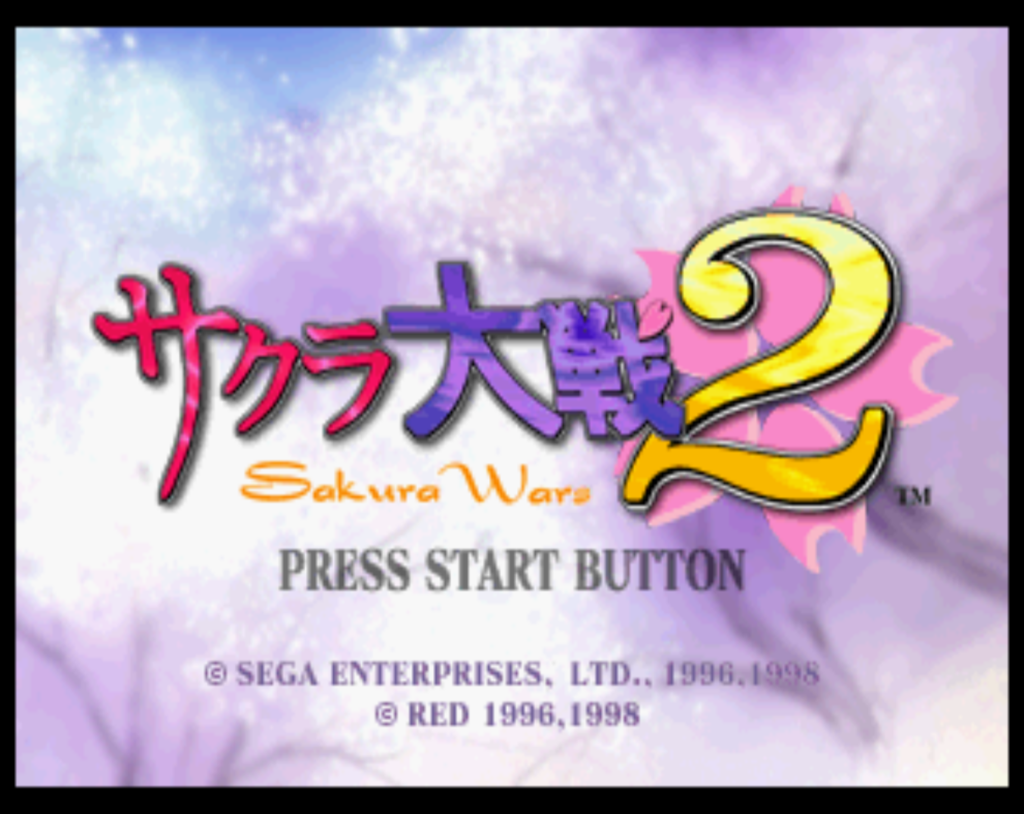
This is the sequel to the original Sakura Taisen, which I covered earlier — the game is essentially the same as the first one so I won’t go over the basics again. There are only a few new features in the battles. There are combination super moves (which I never found useful), and then if two of your characters are both in range of an enemy there’s a random chance that they will join together in a combo attack. Finally, Ogami can change the overall tactics of the group which raise or lower move, attack, or defense. This last one is the only new feature that I found really changed the in battle tactics.
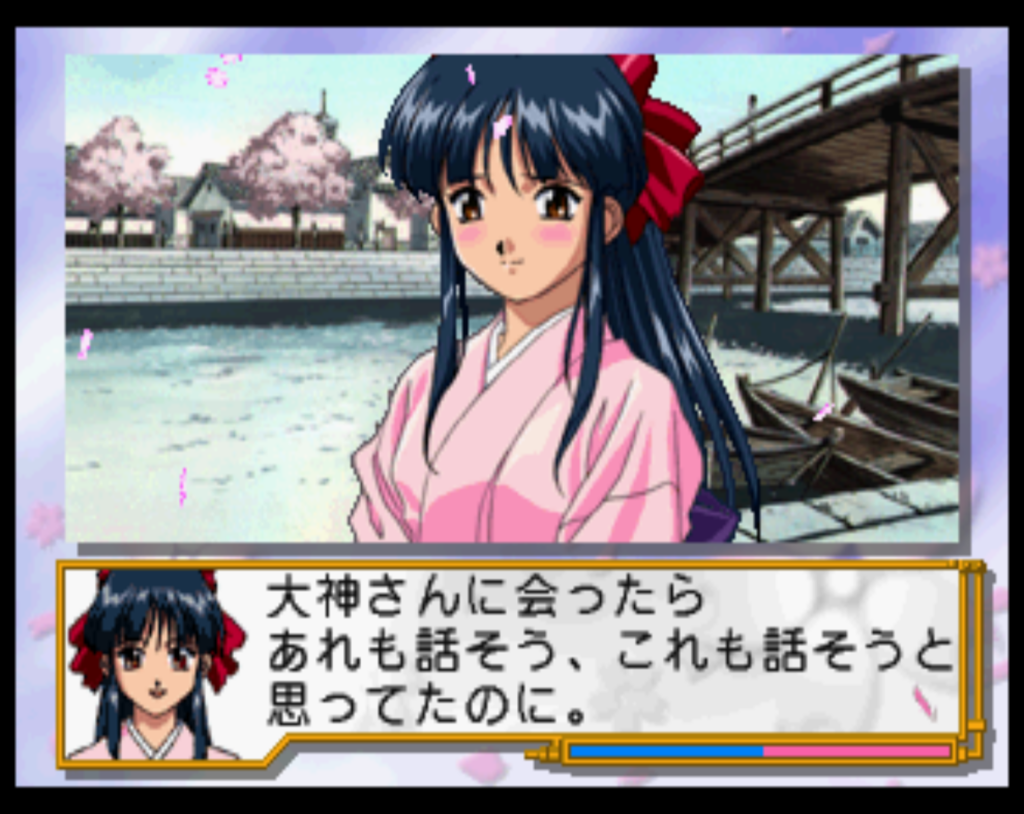
Ogami has been away from the theatre troupe for a year, and now he is back to meet his one true love Sakura. But of course new enemies threaten Tokyo. All of the girls from the first game return, along with two new ones.
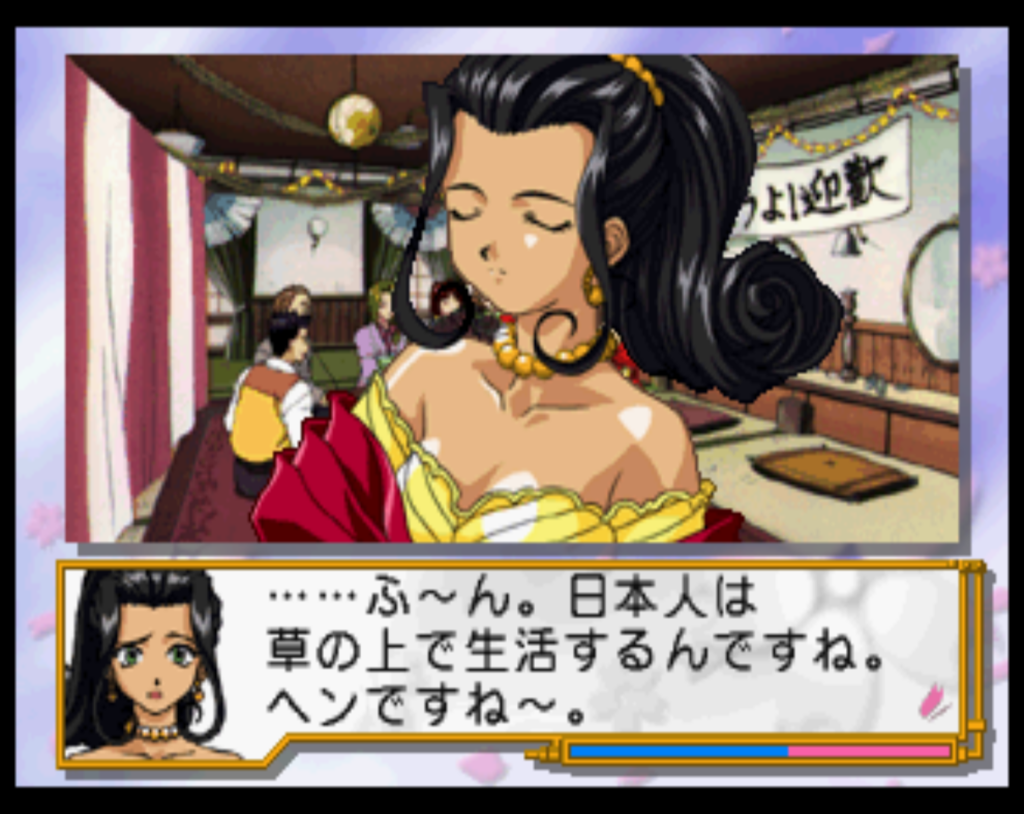
Orihime is a half-Italian woman who seems to hate all Japanese men. Her mech has an area of effect attack although it does not target the spaces immediately adjacent to her.
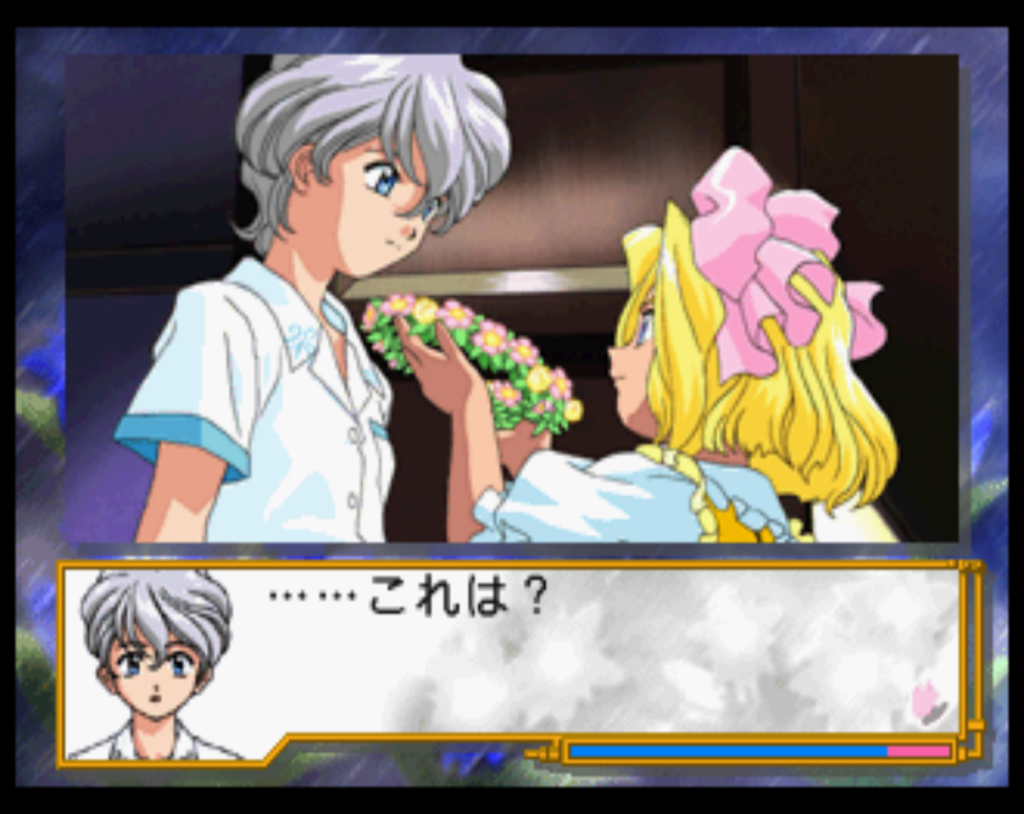
Reni is from Germany; everyone thinks she’s a man at first but it turns out she is a girl. Her attack is like Sumire’s but it’s a 3-range rather than just 2.
The first stages proceed along the same lines as the first game — they’re a chance to introduce the new characters, revisit the old ones, and introduce the enemy group. This time the group is five demon-like characters headed by “demon mask”, called the Black Five.
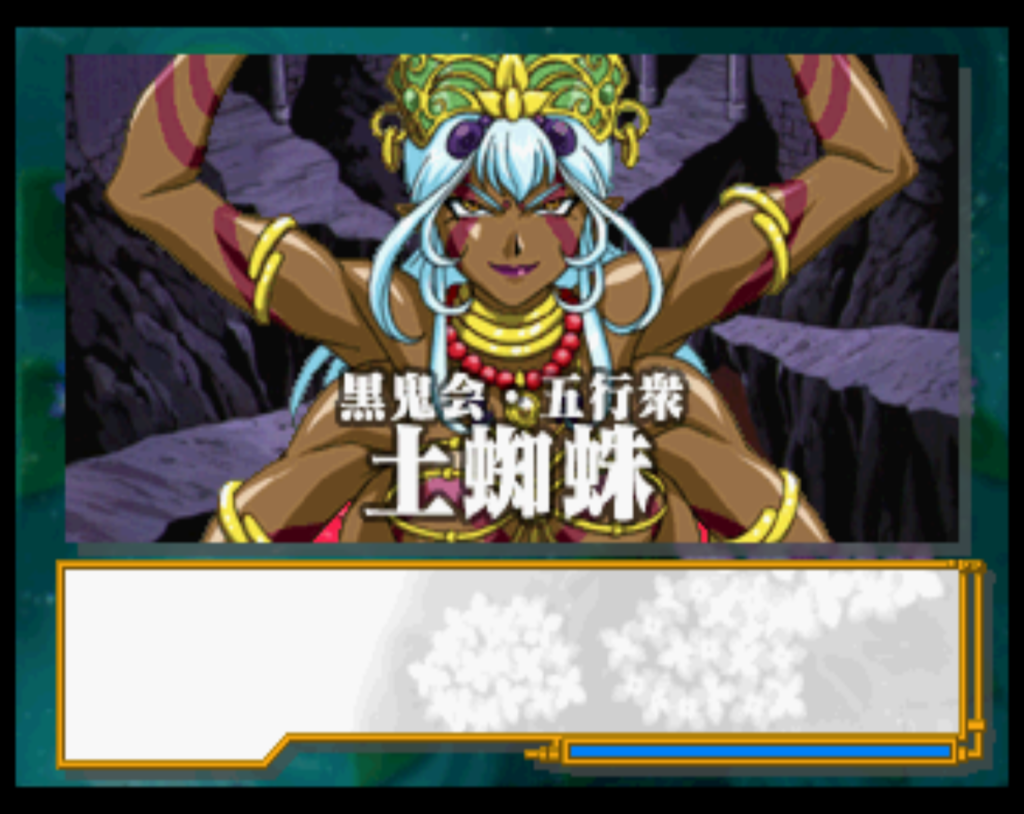
In these first stages there’s not a whole lot of information about what the enemy’s goal is; they are doing everything for a certain unnamed person, and their main aim at first seems to be just to eliminate the Flower Battalion. In the first set of stages we manage to kill two of the five (Kasha the fire obsessed guy, and Suiko the ice person). At the same time, the Battalion is facing pressure from the army. One of the higher ups in the army (Kyogoku Keigo) does not like the group and uses political pressure to cut the funding, although we manage to reinstate it later.
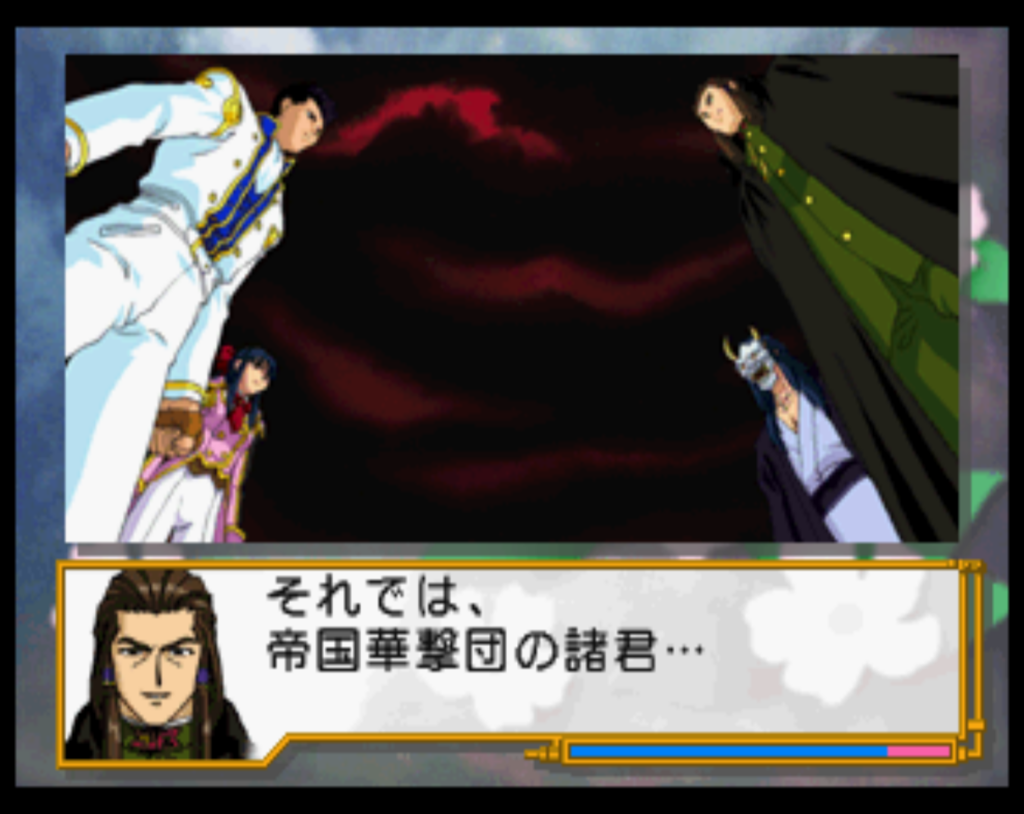
Eventually these two strands come together as Kyogoku tries to take over the government with the help of the Black Five. However, we manage to thwart the group and Kyogoku commits suicide after the rebellion fails. After this there is an entire chapter that has no battles. For me, Ogami went to visit Sakura’s house but I think that’s because my love value with Sakura is the highest — I wonder if there are different scenes for all the different characters.
But of course the game is not over yet because there are still 3 stages. In the first game there was also this kind of double plot, but the second part went into some pretty bizarre places. The story this time is a little more grounded, I suppose. It turns out that Kyogoku did not actually die, and all the battles in the first part really had nothing to do with overthrowing the government. They were actually to gather power to revive an ancient flying fortress called Musashi that Kyogoku will use to cleanse the capital and rule over it as a new emperor.
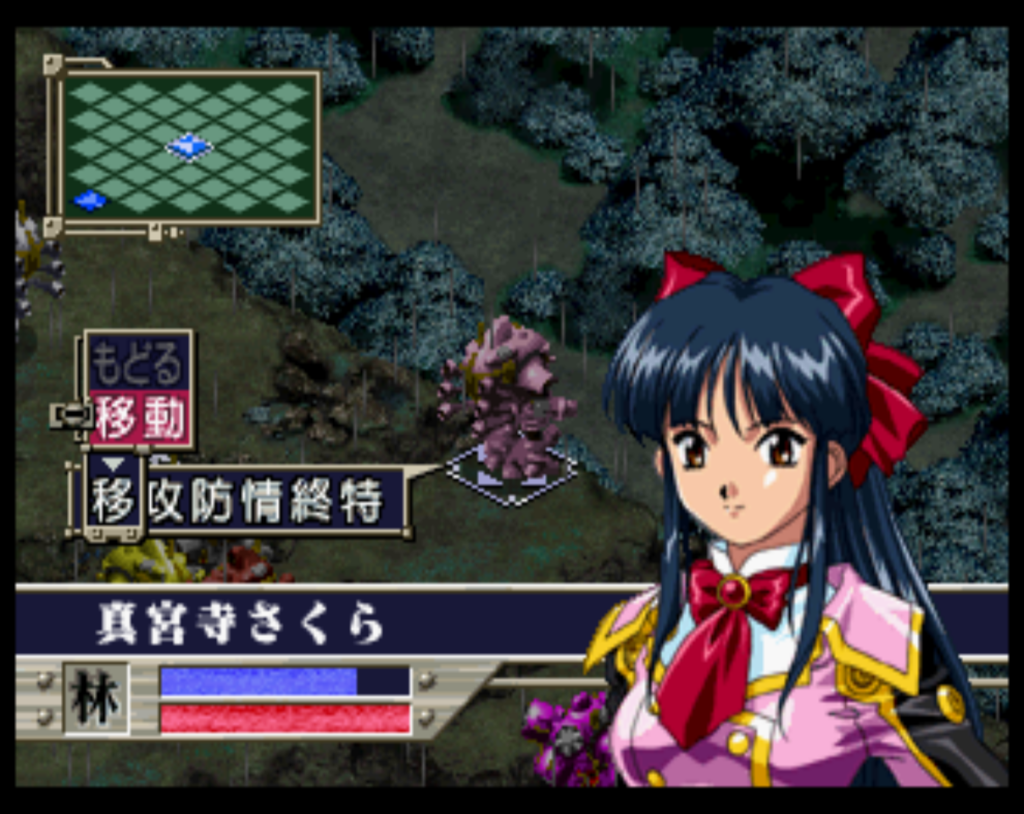
But we use the revamped airship from the last game to make it to the Musashi. It turns out that the Demon Mask is Sakura’s dad, who has been revived by Kyogoku.
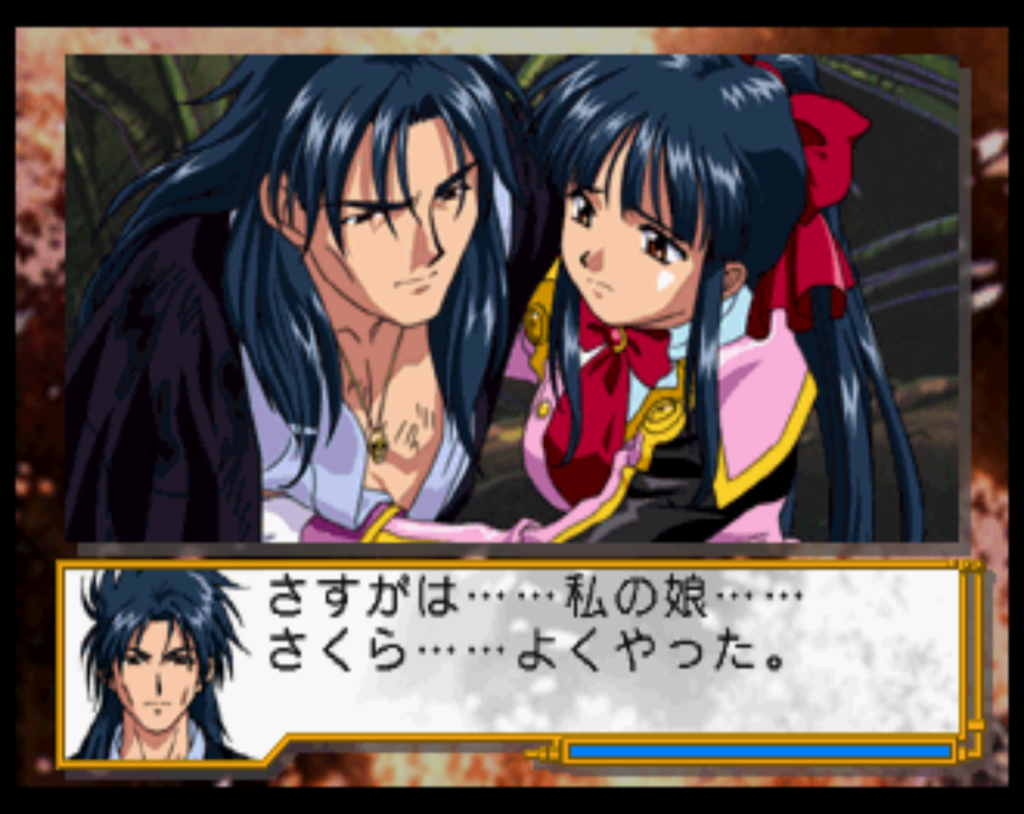
After a tearful reunion he helps us defend against Kyogoku’s attack but dies again in the process, and then we have to get to the main room to destroy all the power generators. Eventually Kyogoku ends up getting absorbed into a big robot called Shinno that serves as the final boss.
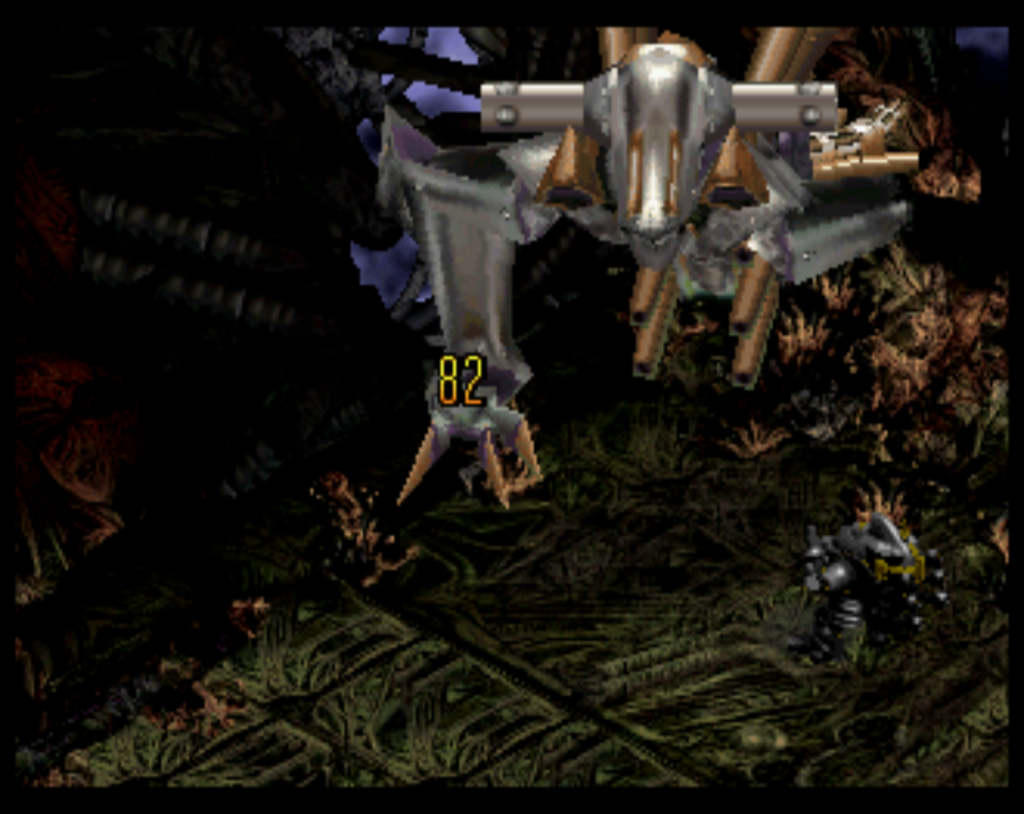
The game ends with Ogami getting promoted but then sent off to France on assignment which sets up for the third game.
Overall, I think the story was enjoyable enough. It had some similarities to the first game but I liked the links to the Kouma War that had been mentioned before and the new characters were interesting. The gameplay wasn’t as interesting. One reason I’m doing SRPGs instead of just strategy games is that I like to have some control over the development of your characters, and here it’s basically just fixed upgrades (along with the trust bonuses from the adventure part). I still don’t like how you can waste time wandering around to empty locations during the free time sections. I think I have to give this game a B rather than the A rating I gave to the original game; I don’t think that means that ST1 is a better game than ST2. I think it’s simply that I was more interested in ST1 because it was new and a shorter game overall, and it’s in a genre that I’m not going to like as much as true SRPGs. I will play the third one, though.
For the next game, I wanted to play a PS1 RPG so I asked Karkalla‘s discord for suggestions. The first one was Grandia, a game I have always heard about, so that will be next. However, Grandia seems like a rather long game so I think what I am going to do is switch off between that and Shining Force III Part 2 each week.
Kind of off topic, but can I ask a S-RPG in general question from the various games you’ve played?
Also if this isn’t the place, do you know I good place where I can ask?
Sure, you can ask.
Have you ever found an S-RPG, preferrably Fire Emblem style, where a low movement unit, as movement in how many squares they can move, is high tier?
Preferably this would be a case where they are lower movement than regular movement units and high movement units.
The reason I ask this is I’ve played alot of Fire Emblem and several similar games. Anyhow in Fire Emblem there’s a class called Armored Knight which is lower movement than both infantry units(normal movement) and cavalry/flying units(high movement).
In all Fire Emblem games, even the newest games, Armored Knight is ALWAYS low tier and Fire Emblem has continually failed to make them good as low movement is that much of a killer. Even the only Fire Emblem clone I’ve found that made Armored Knights good, did so via giving Armored Knights the same movement stat as infantry units.
So I’m curious to see if any S-RPG has high tier low movement units.
Bonus points if they are a mostly melee unit/don’t have super long range and extra bonus points if its a game without the ability to create units?
Hmm, that’s a tough question to answer. I think you are right that in general, low movement characters often suffer, particularly when the maps are larger. They may try to compensate with increased other stats, but it’s difficult to make up for not being able to reach the enemies.
Part of the issue is that the earlier SRPGs I’ve been playing have a lot of balance issues even aside from the low movement characters so I can’t really think of one.
Ah unit balance never really improves in Fire emblem style S-RPGs, though they are at least single player anyhow.
But even in the new Fire Emblem games, there’s a HUUGE gaps between “Godlike units” and “Can never do anything right units”, some of the worst units in FIre emblem history came from the newer games believe it or not! The very worst unit in Fire Emblem history came from the DS remake of Mystery of the Emblem!
But even the newest Fire Emblem games and similar S-RPGS like Unicorn Overlord have trouble making low move armored knights good.
I think a major issue with low movement units is units with low stats and high movement can eventually improve their stats and become just as powerful as a low movement unit, but a low movement unit like an Armored unit is low movement forever with ONLY two games having movement growth, which even there has a growth rate below 10%!
One thing that could be cool is if you play a S-RPG with a notably useful low movement unit, you could note it in your review/post on the game?
I suspect the fundamental root of the issue is that most developers don’t experiment around enough with different objectives and victory conditions. The VAST majority of SRPGs haven’t evolved past the simplicity of Tactics Ogre or FE1, and are content to just do “kill all enemies” or “kill the boss” as the victory objective. So naturally, OF COURSE high mobility units will be the most useful ones. As long as you’re designing within that framework, I’d say it’s folly to try and make armored units be really powerful — it’s essentially trying to force a square peg.
The simple solution would be to include varied victory objectives and an abundance of side objectives which involve chokepoints. FE10 actually did this to an extent, making units like Brom and Tauro useful, in 2-E and 3-13 respectively. Lost Eidolons achieved this with some of its maps rewarding defensive play, allowing healers and tanks to flourish. In these situations, you’re making low mobility units a lot more useful, even if they’re not high tier.
…Either this, or you radically reshape the core engine of your SRPG or TBS entirely. Defend the Rook is an excellent hybrid tower defense/TBS game which sometimes offers you the choice to have reduced mobility in exchange for other perks like AoE, splash damage, extra range, and such. It took a lot of cues from Warriors of the Nile, another terrific game in the same mold. In these games, mobility isn’t everything, and you’ll often find that the game rewards various different playstyles. King Arthur: Knight’s Tale is another SRPG where tanks fulfill a valuable niche. (If you like Darkest Dungeon and/or the Firaxis XCOM games, you’ll probably like KAKT.)
That’s a good point — the situation can also be exacerbated by any element of the game that makes it so you have to (or should) clear the maps quickly. I think slow tanks tend to be the most useful in games where you can keep your forces on defense and wait for the enemy to come to you.
The slow units sometimes have to be used because you don’t have enough units to cover everything, or because the way the system is set up you can’t just use a few power units to do everything. But in those games the slow movement is just an annoyance because it more or less pegs your entire group’s movement to the slowest members.
Your example of FE10 Armor knights is the most logical thing on how to make armor useful, making a wall. Other FE made it but in a very odd way.
FE7 has some maps with reinforcements at your starting point, where Merlinus stays. Having units like Oswin to bait the enemies to protect Merlinus is a good way to make Oswin good, and not just Cav > amor, bench Oswin.
This video is about how phrases like “high mov > low move” got misinterpreted and players who don’t actually play the game spread the misconceptions
“Why Oswin is Good and Lowen is Better: A Critique of Elitism”
FE11 H5 enemies has maximum physical damage at ~34, so the max defense of 30 from General is interesting to use as a wall and bait in no warp skip runs.
FE12 Maniac, Lunatic, Lunatic Reverse mode prologue is a puzzle mess of understanding that enemies prioritize kill > high damage > not get countered
using armor knight kriss is going for the easy way of defensive brute forcing
while fighter is going for the high damage , HP management and positioning playstyle.
I don’t like echoes so much, but it’s funny how the game tried to balance the classes. In the early game, soldier->armor knight class line is useful to bait enemies in a rout game
Engage tried to make Armor knight good, making them immune to break in combat (break is using weapon triangle advantage to cancel counter attack).
The defense stack on armor knight works on hard, but on maddening it doesn’t because the enemies just ignore units they can’t do damage.
I think armor knights are more interesting as enemies class, specially if their defense is very high, incentivizing effective weapons and magic.
Watched some gameplays to remember some chapters
I prefer Sakura Wars 2 because it has more things to do during combat. Like protecting a car, defeating the boss clones. defeating the gold boss first because he also protects the blue boss like Ogami protect the girls, etc.
Going to play Sakura wars 3 someday